“Eberhard analyses precisely, contours sharply, deconstructs without hesitation and contrasts hard, (…) transparent and dry in expression, humorous and biting in commentary.” (Tobias Böcker, JAZZPODIUM)
“Silke Eberhard draws all her blowing art without mutating her music into a mere presenting technical skills on the instrument. No, it is highly compressed and complex music …” (Heinrich Brinkmöller-Becker, nrwjazznet.de)
“Silke Eberhard’s strength and uniqueness is not that she conveys, but that she confronts, that she does not draw soft shades, but leaves sharp contours on the auditory membrane with a sure hand.” (Wolf Kampmann)
“Eberhard (…) becomes a firebreather: huge interval jumps and special effects. A passionate beat on beat aesthetics can be heard, music, sometimes born out of delusions. ” (Christoph Merki, Tages-Anzeiger)
“…Arguably the festival’s most successful tribute was alto saxophonist Silke Eberhard’s POTSA LOTSA.” (Laurence Donohue-Green, Allaboutjazz)
Downbeat Critics Polls – 67th – 66th – 65th – 63rd Downbeat Critics Poll
Jazzpreis Berlin 2020 – RBB24
all reviews Silke Eberhard Trio “Being The Up and Down” (2021): Intakt Records
all reviews Silke Eberhard Trio “The Being Inn” (2018): Intakt Records
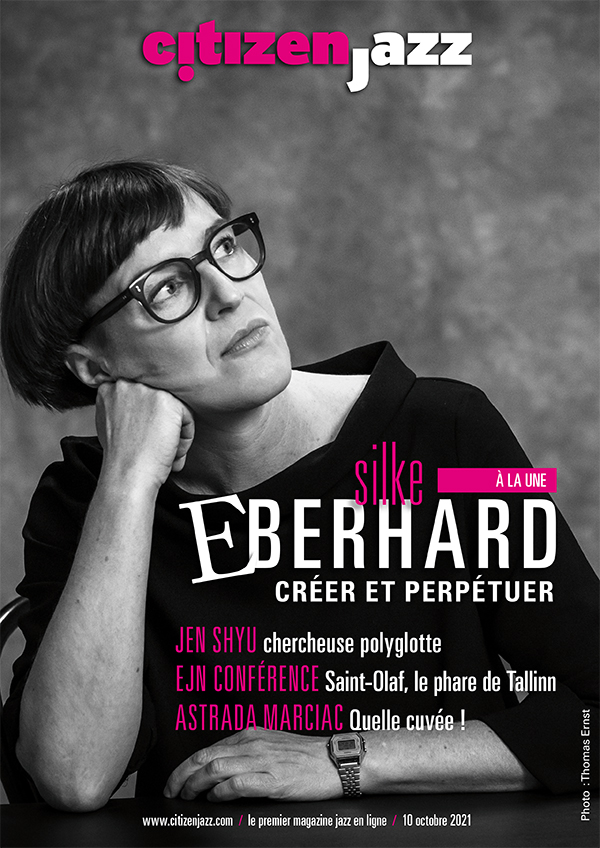
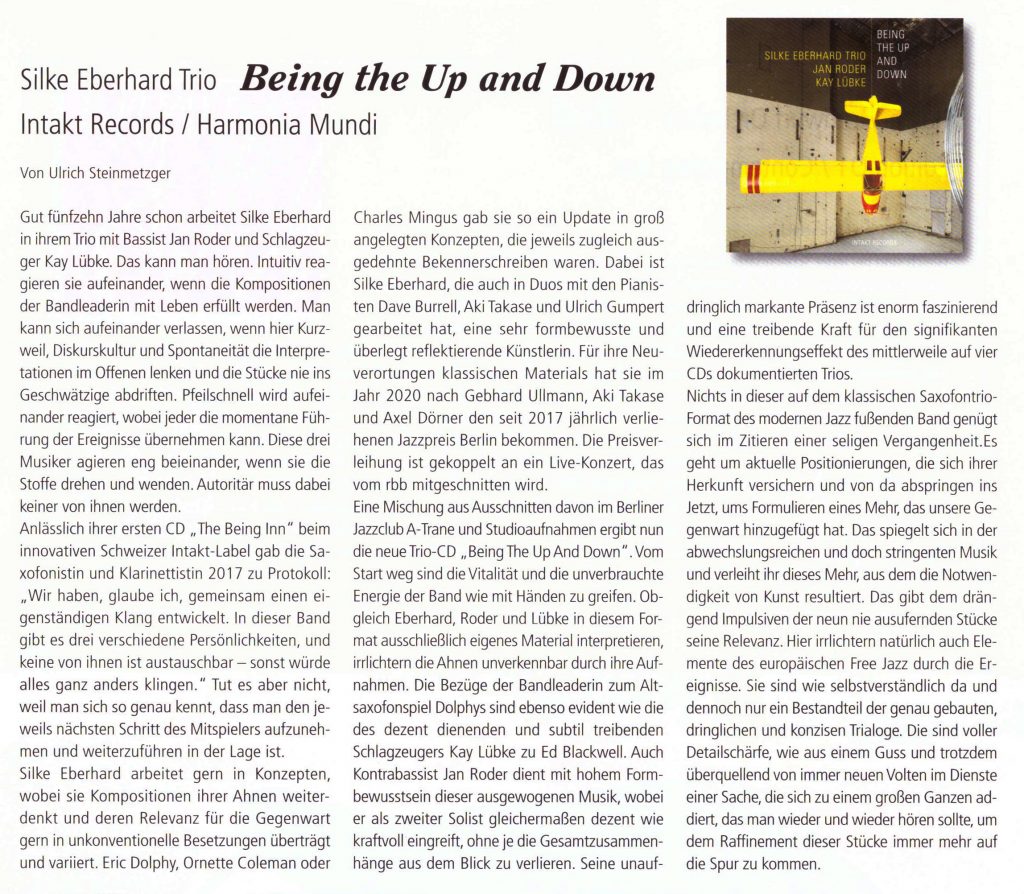
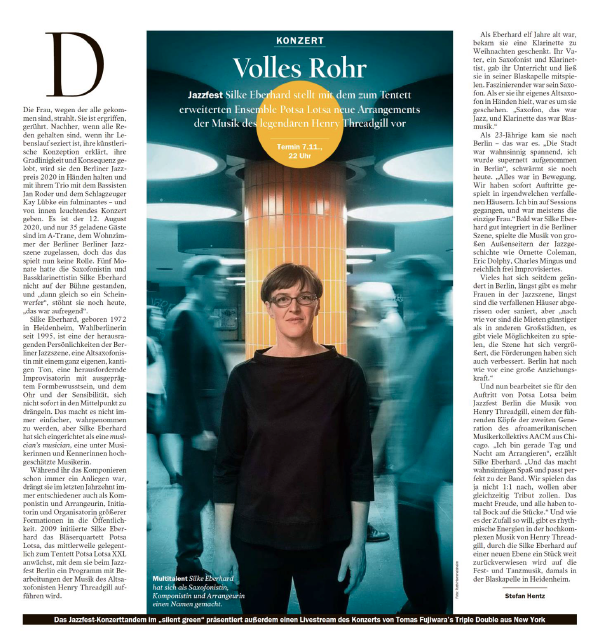

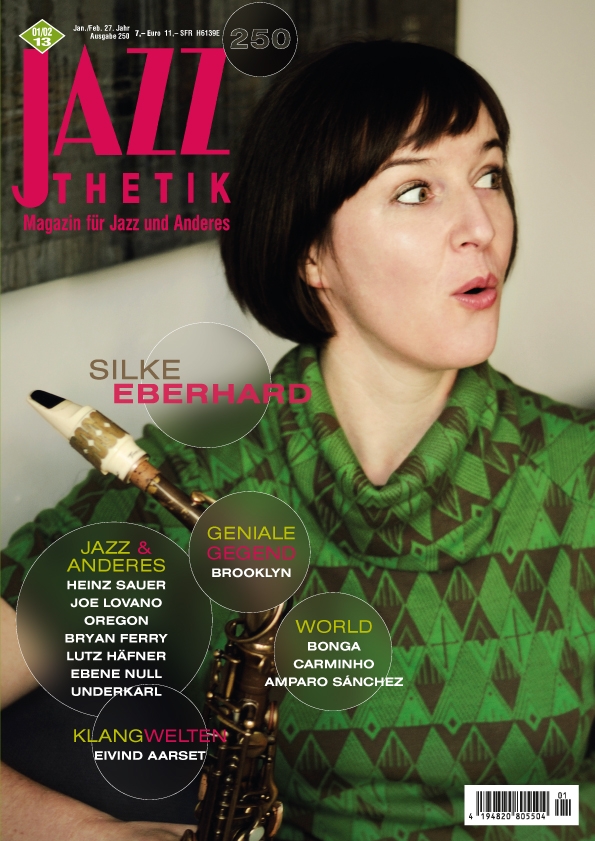
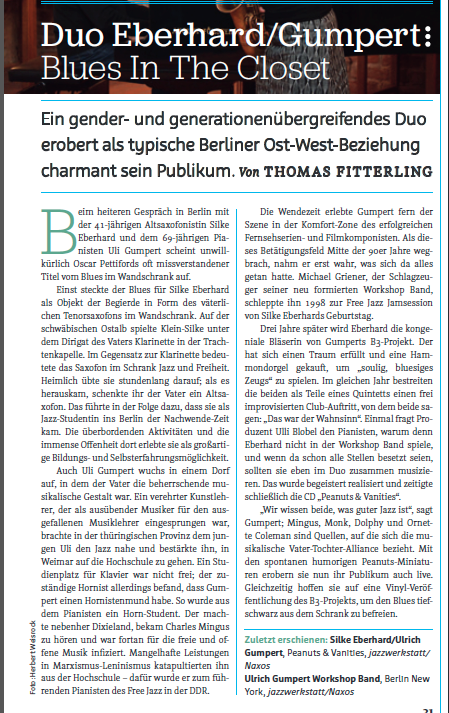
Review – Solo Concert in Wuppertal, 2015: “Extremely concentrated the musician elicits her alto sax a firework of woodwind art. Nimble runs in all positions, almost melodic passages that dissolve into entropy, screams, cries for help, answers phrases, key sounds, rhythmic patterns, which also change again dynamically, multiphonics by singing along, a downright sprawling motifs and stylistic diversity in rapid changes – Silke Eberhard draws all her blowing art without mutating her music into a mere presenting technical skills on the instrument. No, it is highly compressed and complex music .. Nevertheless, Silke Eberhard´s playing has an infectious lightness, a certain wit and shrewdness. How much of this have instant composing or compositionally fixed patterns, one can only guess. The meter long notation in panoramic format with many colors and cryptic characters (and also notes!) leaves the outsider anyway to inconclusive.” (nrwjazz.net, review by Heinrich Brinkmöller-Becker)
– Weiterleben in den Klängen by Franziska Buhre, TAZ June 25, 2014
The New York City Jazz Record, CD Review Singen sollst Du + Peanuts & Vanities by John Sharpe, April 2013
Portrait Jazzthetik Jan/Feb 2013
Jazzpodium Peanuts & Vanities CD Review by Klaus Hübner, February 2013
Fonoforum Peanuts & Vanities CD Review, February 2013
All about Jazz : Jazz Fest Berlin, by Henning Bolte, Nov. 2012
(Freejazz-Stef CD Review Silke Eberhard / Alex Huber: singen sollst Du…
Jazzpodium Silke Eberhard and Dave Burrell, by Thorsten Meyer, April 2012
Jazzpodium Review by Klaus Hübner (April 2012) Silke Eberhard/Dave Burrell Darlingtonia (Jazzwerkstatt/Records)
Interview Jazzpodium (Page1) – (Page 2) June 2011
The NEW YORK CITY JAZZRECORD CD Review Potsa Lotsa, by John Sharpe, June 2011
RONDO-Musikmagazin Silke Eberhard Trio: what a beauty being, ***** (5 stars), by Thomas Fitterling, May 2011
Jazzpodium Trio Review, by Reiner Kobe, May 2011
Jazzthetik Tonspuren by Rolf Thomas, März/April 2011
DOWNBEAT MAGAZINE – Dec. 2010: European
Scene: “German Saxophonist reimagenes Eric Dolphy” by
Peter Margasak.
SONIC – Nov./Dec. 2010 Ein lang gehegter Wunsch (1) page
2) Interview by
Ulrich Steinmetzger.
Downbeat, by John Murph, December 2009:
“Indeed, collective improvisation was the common denominator for many of the German musicians, especially during Silke Eberhard and Potsa Lotsa`s rousing send-up to Dolphy. A horn quartet led by alto saxophonist Eberhard and featuring tenor saxophonist Patrick Braun, trumpeter Nikolaus Neuser and trombonist Gerhard Gschlössl, Potsa Lotsa brought sparkling imagination, collectice improvisational zing and humor to the proceeding as they delved into Dolphy classics such as “Hat and Beard”, “Straight up and Down” and “Burning Spear” with no one playing bass clarinet or flute. A reason why the group´s performance was so magical was that none of the members seemed intent on playing Dolphy but rather playing his music.”
Allaboutjazz New York, by Laurence Donohue-Green,
November 2009
“…Arguably the festival’s most successful tribute was alto saxophonist Silke Eberhard’s POTSA LOTSA (the group named after an obscure Dolphy composition titled “Number Eight—Potsa Lotsa” from the seminal At The Five Spot) at the Oval Room. In a chamber music aesthetic, she showcased a sampling of nearly two dozen Dolphy tunes arranged for a unique quartet of alto (Eberhard), tenor (Patrick Braun), trumpet (Nikolaus Neuser) and trombone (Gerhard Gschlossl). Offering an enlightening listen to the composer’s singular works, the double reed/double brass group thrived in this setting, only their fourth-ever live performance. Giving this tribute additional significance as ultimately a tribute to Dolphy the composer versus player, Eberhard didn’t make much in the way of any noticeable efforts replicating
Dolphy’s playing style (rarely did she even reflect a direct Dolphy stamp on her own playing), nor did she try to incorporate two other instruments closely associated with Dolphy—one of which she has been known to play—flute and bass clarinet. The group successfully melded Dolphy’s jazz with an overt classical facet, offering a refreshing listen to such intricate compositions as “Burning Spear,” “Out There”(an alto/trombone feature, with Gschlossl ferociously spitting out walking bass lines), “The Prophet” (an excellent if not obvious selection with its inherent compositional beauty lending itself to the classical chamber ensemble interpretation and textural two, three and four part harmonies of various instrument combinations),”Serene”(featuring more demanding Dolphy lines that understandably found Eberhard actually gasping for breath before squeezing out the piece’s final note after consecutively demanding and lengthy lines), the obligatory “Out to Lunch” (Gschlossl interweaving short jabs and long tones with Neuber while the two saxophonists provided a line
underneath before the reeds took centerstage, frenetically bleeting, blowing, popping, then leading back into the strolling head as an empathetic as-ever foursome) and “Straight Up and Down/Hat & Beard” (given an intriguing bolero undertone). An already highly anticipated 2010 Jazzwerkstatt CD release is on the way, so be on the lookout for this one! …”
Silke Eberhard Trio:
Best of 2008!
Chicago Reader – Post No Bills, by Peter Margasak
Silke Eberhard Trio, Being (Jazzwerkstatt)
Young Berlin reedist Silke Eberhard has caught my ear before–particularly on a program of Ornette Coleman tunes recorded with pianist Aki Takase –but she really hits pay dirt here. Her tart tone clearly influenced by Ornette, she braids her generous improvised melodies through swinging structures sketched out by bassist Jan Roder (Die Enttäuschung) and drummer Kay Lübke.
Review: Silke Eberhard Trio – Being (Jazzwerkstatt, 2008) ****
I got to know Silke Eberhard from her duo recording with Aki Takase, playing Ornette Coleman’s music. She now releases her new trio album, “Being”, with Jan Roder on bass and Kay Lübke on drums. Eberhard herself switches between alto sax and clarinet. Her mastery of both instruments is impressive, but so is her take on music : it is fun, it
is light-footed, rhythmically and structurally complex, emotional and technically superb. Eberhard is familiar with jazz history, and starting from swing jazz clarinet, over Jimmy Giuffre to more modern players like Rob Brown, covering the whole range, integrating it and turning it into her own miniatures. Her playing is not expansive, but highly sophisticated in its changes of motifs and styles. The first
track “Calypso” sets the tone, starting with a high swing it moves toward some free blowing in the middle part, only to fall back in the most natural of ways into the initial tune. All the tracks are highly rhythmic, and that’s part of the fun, over which her sax or clarinet sings and dances, mostly without fixed melodies or themes, mostly abstract, yet free as a bird, and that’s the other part of the fun. Even the slower tracks, such as “Rockballade No 51”, keep that abstract compositional level, and stay away from cheap sentiments. “Waxing Moon” is a pure avant-garde intermezzo, and the 26 seconds long track”Little Hare” could have come from the pen of Ornette Coleman. Fun indeed. The record ends with “I Love Every Human Being”, again in full lyrical swing mode, full of lightness and joy. This combination of joy and
forward thinking in music is possibly the album’s greatest strength.
Avant-swing? Avant-bop? http://freejazz-stef.blogspot.com/2008/10/silke-ebherhard-trio-being.html
October 16, 2008
Arm, aber sexy,
Jazz in Berlin im Höhenflug, von Christoph Wagner
Neue Zeitschrift für Musik, Juli/August 2008
“Ungewohnte Töne – Bei Silke Eberhard schon! Die Berliner Saxofonistin hat ihr Trio Being mit einer klassischen Rhythmusgruppe besetzt – dennoch schlägt das Ensemble ungewohnte Töne an. Mit leichter Hand skizzieren die drei einen aufgeklärt modernen Jazz, der die Intuition und Intensität kreativer
Improvisation in kluge Arrangements einbettet und mit der Finesse eines harmonisch und rhythmisch geerdeten Post-Bebop verwebt. Geschickt werden die Fallen der Vorhersehbarkeit umgangen und nicht ein Solo an das andere gereiht. Darüber hinaus wird das Rollenverständnis von Führungs- und Begleitinstrumenten fortwährend durcheinandergewirbelt. Kein Instrument dominiert – alle begegnen sich auf gleicher Augenhöhe.”
Christoph Wagner, Neue Zürcher Zeitung , 28. Juni 2008
Jazzzeitung,
Critics Choice – Charts 04/2008
Silke Eberhard Trio: Being; Jazzwerkstatt 027
Sie spielt in einer „klassischen“ Besetzung des Free Jazz, im Trio mit Kontrabass und Schlagzeug ohne Harmonieinstrument. Doch Eberhard wiederholt die Geschichte nicht, sie setzt sie fort – ein frischer Ausblick auf eine Musik, die noch immer im Werden ist und die Klischees hinter sich gelassen hat.
Bert Noglik, MDR
SILKE
EBERHARD TRIO Being (Jazzwerkstatt, jw027): NowJazz im klassisch modernen Stil, komponiert. Schwarze Wurzeln, dabei im Schwabenland aufgezogen, in Berlin ausgereift. Nur wenn man es in Worte fassen will, wird das, was Silke Eberhard tut, paradox und kompliziert. Sobald sie mit Altosax & Klarinette zu spielen beginnt, was sie von den Großen – Ornette Coleman und Aki Takase wären da zu nennen – aufgesaugt und in
Eigenkompositionen in Form gebracht hat, ist alles so einleuchtend und sonnig wie der Colemaneske ‚Calypso‘, so easy wie ‚Besenswing‘, so zartbitter gesungen wie die ‚Rockballade No. 51‘ oder ‚Jetzt doch!‘, so spritzig und sprunghaft wie ‚Ping Pong‘. Für diese binnenrhythmische, federnd swingende Sprungkraft, die im Kopf ja schon so sehr da ist, dass der Mund überläuft, hat sich die Jazz-Pott-Preisträgerin 2007 (best progressive artist) verbündet mit Jan Roder am Kontrabass und Kay Lübke an den Drums. Der eine ist Eberhard-vertraut seit 1996 und bringt seine Erfahrungen mit Die Enttäuschung und Monk‘s Casino mit ein, der andre als vielbeschäftigter Freelancer und ebenfalls als Duopartner der Saxophonistin. Dabei rollt Lübke so rund und klappert und besenswingt so geistesgegenwärtig, dass es eine Freude ist. Eberhard macht dazu nicht auf niedliche kleine Hexe, sondern ist von Song zu Song die Sophisticated Lady, der einfach nichts Banales gelingen will, wenn sie ihre eigenen Gedanken singt, auf der Klarinette besonders beschwingt und gescheit. Da ist sie bis in die Haar- und Fingerspitzen cool, Giuffre-cool, Paul-Desmond-cool, mit Bedacht leichtsinnig, ein Wildfang, der treppauf-treppab gern einige Stufen überspringt. Das
abschließende ‚I love every Human Being‘ mit seinem Soloreigen zu schierer Klarinettenpracht im Bom-bom-bombombadom-Groove ist ab sofort Unterrichtsstoff. Rigobert Dittmann, Bad Alchemy 58, 2008
PORTRAITS:
“Die Freiheit ist die Tradition” Portrait,
von Tobias Richtsteig
Jazzpodium, Mai 2008
“Die Himmelsmechanik.” Portrait,
von Sybille Zerr
Jazzthetik, Januar 2008
“Improvisation als großes Rätsel” Portrait, von Ulrich Steinmetzger
Sonic, Januar 2008
“Silke Eberhard is a reed player to watch.” All about Jazz, USA, December 15, 2007
“(David) Liebman kann hier seine ganze Vielseitigkeit ausspielen. Silke Eberhard führt er in “Missing Persons” in einen gespenstischen Tanz. Bassklarinette und Sopransaxophon belauern sich, umgarnen sich und jagen einander dann weiter durch die Nacht.” Thorsten Meyer, Jazzpodium, Juni 2008
“Del tutto particolare (e senza precedenti) anche il tipo di duetto che qui è alle prese con un repertorio originariamente concepito nella sua stragrande maggioranza (fatta eccezione per i pezzi registrati per la prima volta in Something Else!!!) per una formazione senza piano, strumento che Coleman ha sempre considerato (soprattutto tra la fine degli anni Cinquanta e i primi anni Sessanta) un limite più che un valore. E il pianoforte che in questo CD si rivela dinamico e ricchissimo di risorse cromatiche, lungo un abbondante dialogo con la Eberhard che dà una prova di grande espressività, tecnica e che è eccellente anche se esaminata sotto il profilo della sonorità e della pronuncia. Aspetti questi ultimi che, ça va sans dir, non vanno mai messi in relazione al sassofonista texano con cui i punti di contatto sembrano essere pochi.” *****, Gigi Sabelli, All about Jazz Italy, Februar 2008
“Because Coleman worked without a piano when he recorded these tunes for Atlantic, Takase creates something new out of necessity. Her interaction with Eberhard reflects the crucial spontaneous interplay at the heart of Coleman`s singular performances, the facet that made the music rvoulutionary.”Peter Margasak,
DOWNBEAT, USA, December 2007
“Darüber hinaus verblüffte die grandiose Silke Eberhard im Orgelquartett Ulrich Gumperts …” Ulrich
Steinmetzger, JAZZTHING, Nov. 2007
“Nachts im Club desertierte Ulrich Gumpert zur Hammondorgel und machte mit der umwerfenden Saxofonistin Silke Eberhard Hardbop vom Feinsten.”Leipziger
Volkszeitung 8/10/07
“Für eine sensationelle Überraschung sorgte Ulrich Gumperts Orgelgruppe…Die deutsche Altsaxophonistin verkocht Evergreens wie “Jive Samba” mit den exzessiven Ausdrucksstürmen von Albert Ayler und dem and den Grundfesten der Tonalität rüttelnden Harmonieverständnis von Eric Dolphy. Einen solchen Groove-Teufel hat Deutschland noch nicht besessen.” Ulrich Olshausen, Frankfurter Allgemeine, 18.10.2007
“Eberhard (…) wird zur Feuerspeierin: riesige Intervallspünge und Spezialeffekte. Eine leidenschaftliche Schlag auf Schlag Ästehetik ist zu hören, eine Musik, manchmal wie aus Wahnvorstellungen geboren. ” Christoph Merki, Tages-Anzeiger, Zürich 26. November 2007
“A favorite Record of the year – German reed player Silke Eberhard has been making waves in Europe since the late ‘90s. In addition to her own groups, she has collaborated with Dave Liebman, Johanns Bauer and others. Ornette Coleman Anthology, a set of duets with pianist Aki Takase on Coleman tunes is a real gem. Eberhard plays alto sax, clarinet and bass clarinet and while the
saxophone appears to be her main instrument, she is equally adept on the others.” Robert Iannapollo, All About Jazz USA, November 3, 2007/All About Jazz New York, November 2007
“Die Pianistin Aki Takase brachte zusammen mit der Saxophonisten Silke Eberhard das Publikum im Bamberger Jazzkeller zum Rasen. “Fränkischer
Tag, 1. Oktober 2007
Internationaler Jazz Pott 2007: “Silke Eberhard – Charmante Dekonstruktivistin” Sven Thielmann, September
2007
“Implosives
Nachspiel Aki Takase und Silke Eberhard interpretieren Ornette Colemans alte Stücke neu. Ihre Improvisationen sind kraftvoll und kurzweilig.” Christian Broecking, Die Zeit 20.8.07
“Eberhard analysiert genau, konturiert scharf, dekonstruiert ohne Scheu und kontrastiert hart,…transparent und trocken im Ausdruck, humorvoll und
bissig in den Kommentaren.” Rezension Silke Eberhard Quartett, INT
3393-2, Tobias Böcker, JAZZPODIUM, Mai 2006
“Silke Eberhards Stärke und Einzigartigkeit besteht darin, dass sie nicht vermittelt, sondern konfrontiert, keine weichen Schattierungen zeichnet, sondern mit sicherer Hand scharfe Konturen auf der Hörmembran hinterläßt. “(Wolf Kampmann, 2006)
